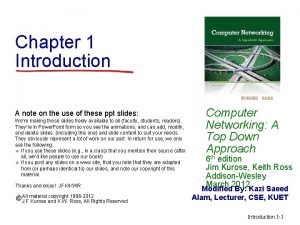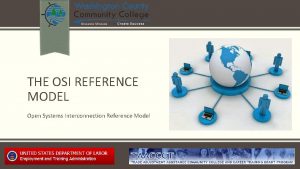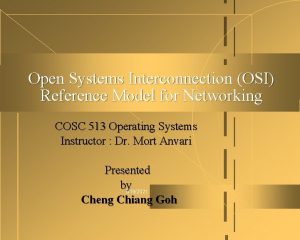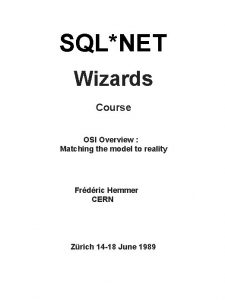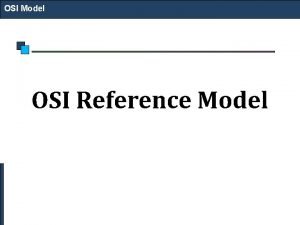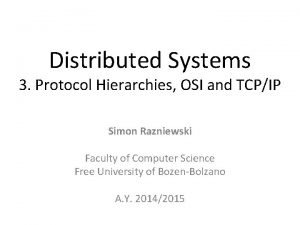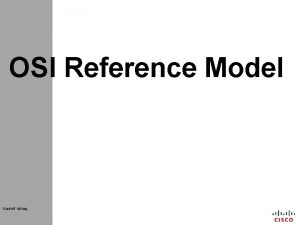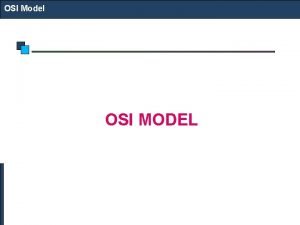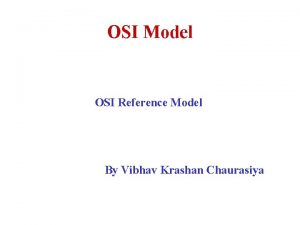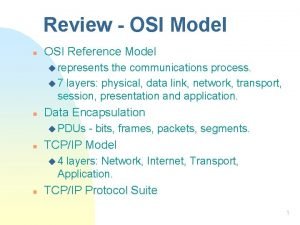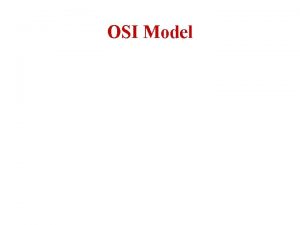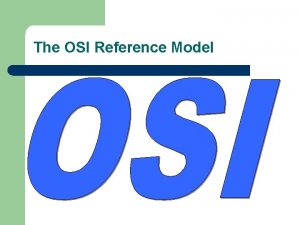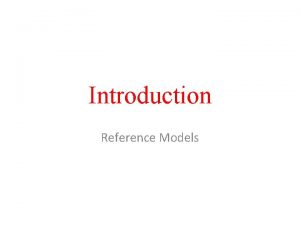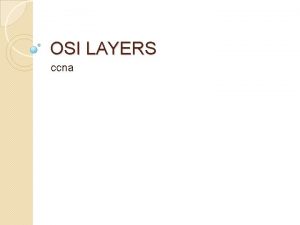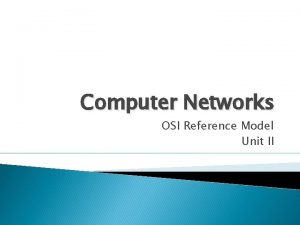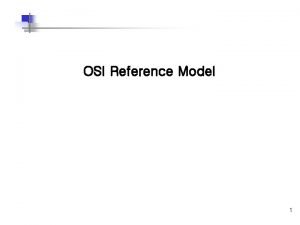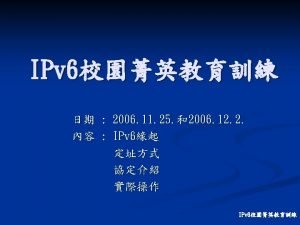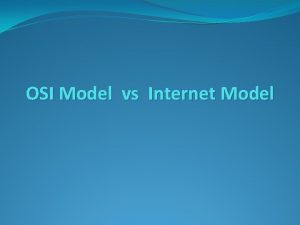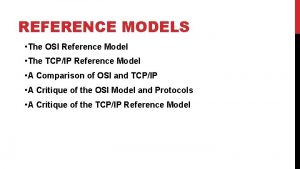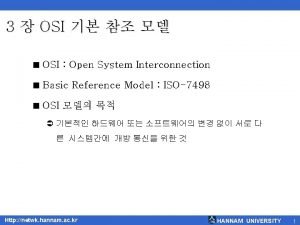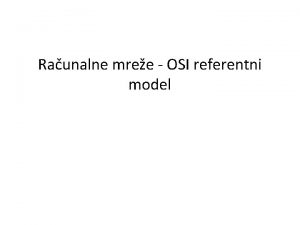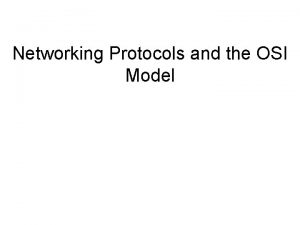OSI Model OSI Reference Model OSI Model The

















































- Slides: 49

OSI Model OSI Reference Model

OSI Model • The OSI model is a layered framework for the design of network systems that allows communication between all types of computer systems. • It consists of seven separate but related layers. • Each layer defines a part of the process of moving information across a network. • An OSI model provides a solid basis for understanding data communications.

OSI Model 7 Layers of OSI Model

OSI Model Layered Architecture • The layers involved when a message is sent from device A to device B. • As the message travels from A to B, it may pass through many intermediate nodes. • These intermediate nodes usually involve only the first three layers of the OSI model. • Each layer performs unique and specific task and it offers services to the layer above it. • For example, Layer 3 uses the services provided by layer 2 and provides services for layer 4.

OSI Model Layered Architecture

OSI Model • Between machines, layer x on one machine communicates with layer x on another machine. • This communication is governed by an agreed-upon series of rules and conventions called protocols.

OSI Model Peer-to-Peer processes • The processes on each machine that communicate at a given layer are called peer-to-peer processes. • At the physical layer, communication is direct: Device A sends a stream of bits to device B (through intermediate nodes). • At higher layers each layer in the sending machines adds its own information to the message it receives from the layer just above it and passes the whole package to the layer just below it.

OSI Model Peer-to-Peer processes • The information added by each layer is in the form of headers or trailers. • At layer 1 the entire package is converted to a form that can be transferred to the receiving machine. • At the receiving machine, the message is unwrapped layer by layer, with each process receiving and removing the data meant for it. • For example, layer 2 removes the data meant for it, then passes the rest to layer 3. • Layer 3 then removes the data meant for it and passes the rest to layer 4, and so on.

OSI Model Interfaces Between Layers • An interface defines the operations and services offered by lower layer to the upper layer. • This is an interface between each pair of adjacent layers. • The passing of the data and network information down through the layers of the sending device and receiving device is made possible by an interface between each pair of adjacent layers.


OSI Model Data Encapsulation • The outgoing information will travel down through the layers to the lowest layer. • While moving down on the source machine, it acquires all the control information which is required to reach the destination machine. • The control information is in the form of Headers and Trailer which surrounds the data received from the layer above. • • This process of adding headers and trailers to the data is called as data encapsulation.

OSI Model Data Encapsulation • • The headers and trailers contain control information. The headers and trailers form the envelope which carries the message to the desired destination.

OSI Model Data Encapsulation • D 7 means the data unit at layer 7, D 6 means the data unit at layer 6, and so on. • The process starts at layer 7 (the application layer), then moves from layer to layer in descending, sequential order. • At each layer, a header, or possibly a trailer, can be added to the data unit. • Commonly, the trailer is added only at layer 2. • When the formatted data unit passes through the physical layer (layer 1), it is changed into an electromagnetic signal and transported along a physical link.

OSI Model Encapsulation example: E-mail

OSI Model 1. Physical Layer • It co-ordinates the functions required to transmit bit stream over physical medium. • Provides physical interface for transmission of information. • Defines rules by which bits are passed from one system to another on a physical communication medium. • Covers all - mechanical, electrical, functional and procedural - aspects for physical communication.

OSI Model 1. Physical Layer The physical layer is responsible for the movement of individual bits from one hop (node) to the next.

OSI Model Functions • Physical characteristics of interfaces and medium. • It also defines the type of transmission medium. • Representation of bits. • sequence of 0 s or 1 s • Data rate. • Synchronization of bits. • Sender and Receiver must be synchronized • Physical topology • Mesh, Ring, Star, etc. • Transmission mode. • Simplex, Half duplex, Duplex

OSI Model 1. Physical Layer • What are the Physical Layer components on my computer? • NIC • Network Interface Card • Has a unique 12 character Hexadecimal number permanently burned into it at the manufacturer. • The number is the MAC Address/Physical address of a computer • Cabling • Twister Pair • Fiber Optic • Coax Cable

OSI Model 2. Data Link Layer • Data link layer attempts to provide reliable communication over the physical layer interface. • • Breaks the outgoing data into frames and reassemble the received frames. • Create and detect frame boundaries. • Handle errors by implementing an acknowledgement and retransmission scheme. • Implement flow control.

OSI Model 2. Data Link Layer The data link layer is responsible for moving frames from one hop (node) to the next.

OSI Model Data Link Layer Functions • Framing • divides the stream of bits into manageable data units called frames. • Physical addressing • adds a header to the frame to define the sender and/or receiver of the frame. • Flow control • imposes a flow control mechanism to avoid overwhelming the receiver. • Error control • adds mechanisms to detect and retransmit damaged or lost frames. • Access control • determine which device has control over the link at any given time.

OSI Model Data Link Layer Functions • Link establishment and termination: • establishes and terminates the logical link between two nodes. • Frame sequencing: • transmits/receives frames sequentially. • Frame acknowledgment: • provides/expects frame acknowledgments.

OSI Model Data Link Layer –Sub Layers • DLL is divided into two Sub-Layers • • LLC Sub Layer MAC Sub Layer

OSI Model Logical Link Control Sub Layer • It is upper portion of the Data Link layer. • Performs Flow control and management of connection errors. • LLC supports three types of connections: 1. Unacknowledged connectionless service: • does not perform reliability checks or maintain a connection, very fast, most commonly used 2. Connection oriented service: • once the connection is established, blocks of data can be transferred between nodes until one of the node terminates the connection. 3. Acknowledged connectionless service: • provides a mechanism through which individual frames can be acknowledged.

OSI Model Media Access Control Sub Layer • This sub layer contains methods to regulate the timing of data signals and eliminate collisions. • The MAC sub layer determines where one frame of data ends and the next one starts - frame synchronization. • There are four means of frame synchronization: 1. Time based, 2. Character counting, 3. Byte stuffing and 4. Bit stuffing.

OSI Model 3. Network Layer • It is responsible for source to destination delivery of individual packets across multiple networks. • Defines the most optimum path the packet should take from the source to the destination • Defines logical addressing so that any endpoint can be identified.

OSI Model 3. Network Layer • Handles congestion in the network. • Facilitates interconnection between heterogeneous networks (Internetworking). • The network layer also defines how to fragment a packet into smaller packets to accommodate different media.

OSI Model 3. Network Layer The network layer is responsible for the delivery of individual packets from the source host to the destination host.

OSI Model Functions of Network Layer 1. 2. 3. 4. 5. 6. Logical addressing Routing. Congestion control Accounting and billing Address transformation Source host to destination host error free delivery of packet.

OSI Model 4. Transport Layer • Purpose of this layer is to provide a reliable mechanism for the exchange of data between two processes in different computers. • • Ensures that the data units are delivered error free. • Ensures that data units are delivered in sequence. • Ensures that there is no loss or duplication of data units. • Provides connectionless or connection oriented service.

OSI Model 4. Transport Layer The transport layer is responsible for the delivery of a message from one process to another.

OSI Model Functions Transport Layer 1. 2. 3. 4. Service point addressing Segmentation and reassembly Connection control Flow control: Flow control is performed end to end 5. Error control

OSI Model 5. Session Layer • Session layer provides mechanism for controlling the dialogue between the two end systems. • It defines how to start, control and end conversations (called sessions) between applications. • This layer requests for a logical connection to be established on an end-user’s request. • Any necessary log-on or password validation is also handled by this layer.

OSI Model Functions of Session Layer 1. Dialog control 2. Synchronization, session and sub session 3. Session closure

OSI Model 6. Presentation Layer • Presentation layer defines the format in which the data is to be exchanged between the two communicating entities. • Also handles data compression and data encryption (cryptography).

OSI Model 6. Presentation Layer • Functions of Presentation layer: • Translation: presentation layer is responsible for converting various formats into required format of the recipient. • Encryption: Data encryption and decryption is done by presentation layer for security. • Compression and Decompression: data to be transform compressed while sending and decompress while receiving for reducing time of transmission.

OSI Model 7. Application Layer • Application layer interacts with application programs and is the highest level of OSI model. • Application layer contains management functions to support distributed applications. • Examples of application layer are applications such as • • • file transfer, electronic mail, remote login etc.

OSI Model 7. Application Layer • Functions of Application layer: 1. Network virtual terminal 2. File transfer access and management 3. Mail services and directory services

OSI Model Horizontal Communication • The horizontal communication is the Logical connection between the layers. • There is no direct communication between them. • Information included in each protocol header by the transmitting system is a message that will be carried to the same protocol in the destination system. • For two computers to communicate over a n/w, the protocol used at each layer of the OSI model in the transmitting system must be duplicated at the receiving system.

OSI Model Horizontal Communication • When the packet reaches at its destination, the process by which the headers are applied at the source is reversed in receiver to get information.

OSI Model Vertical Communication • The header information also enables each layer to communicate with the layer above & below it. Eg. The n/w layer will communicate with the data link layer & transport layer. • This interlayer communication is called vertical communication. • When a system receives a packet & passes it up through various layers the data link layer protocol header includes a field which specifies the name of n/w layer protocol to be used to process the packet.

OSI Model Vertical Communication • The n/w layer protocol header will specify the name of transport layer protocol to be used to process the packet.

OSI Model Connection Oriented Services • Connection-oriented communication includes the steps of setting up a call from one computer to another, transmitting/receiving data, and then releasing the call, just like a voice phone call. • However, the network connecting the computers is a packet switched network. • Connection-oriented communication is done in one of two ways over a packet switched network: with and without virtual circuits. • We can resend the message in connection oriented service if there is an error at the receivers end. • Example of connection oriented is TCP (Transmission Control Protocol) protocol.

OSI Model Connectionless Services • Connectionless communication is just packet switching where no call establishment and release occur. • A message is broken into packets, and each packet is transferred separately. • Moreover, the packets can travel different route to the destination since there is no connection. • Connectionless service is typically provided by the UDP (User Datagram Protocol). • The packets transferred using UDP are also called datagrams.

OSI Model Protocols - Layer 7 HTTP, FTP, SMTP, POP, DNS, Telnet Protocols - Layer 6 Graphics: TIFF, JPEG, GIF Text: ASCII, EBCDIC, Unicode, Encrypted Audio: Midi, MPEG, WAV, MP 3 Video: Quicktime, AVI Protocols - Layer 5 NFS - Network File System, RPC - Remote Procedure Call, ASP - Appletalk Session Protocols - Layer 4 Connection Oriented (TCP), Connectionless (UDP) Protocols - Layer 3 Routing (IP) Protocols - Layer 2 MAC - Media Access Control, LLC - Logical Link Control Protocols - Layer 1 Organizations: IEE, TIA/ETA, ANSI, etc. Cable (ie. RJ 45)

OSI Model Devices - Layer 7 Hosts, PC, Servers, Mobile Phones Devices - Layer 3 Routers Devices - Layer 2 Bridges, Switches, NIC (Layers 1 & 2) Devices - Layer 1 Hubs, NIC (Layers 1 & 2) Media: Coax, Fiber, Twisted Pair, Wireless

OSI Model Summery

Remembering the 7 Layers 7 - Application Away All 6 - Presentation Pizza People 5 - Session Sausage Seem 4 - Transport To 3 - Network Need Not 2 - Data Link Data Do Throw

Que. : Name the layer which is associated with the transmission media. Que: Write the name of layers that perform the following functions in OSI : I. Data Encryption II. Error Correction III. File Transfer IV. Data Encoding Que: What is token passing? List any four protocols associated with application layer of OSI model.
 Presentation layer in computer networks
Presentation layer in computer networks Osi reference model ppt
Osi reference model ppt Osi modle
Osi modle Disadvantages of osi reference model
Disadvantages of osi reference model Osi model diagram
Osi model diagram Physical layer in osi model examples
Physical layer in osi model examples Why and when osi reference model was invented
Why and when osi reference model was invented Reference node and non reference node
Reference node and non reference node Reference node and non reference node
Reference node and non reference node Hình ảnh bộ gõ cơ thể búng tay
Hình ảnh bộ gõ cơ thể búng tay Slidetodoc
Slidetodoc Bổ thể
Bổ thể Tỉ lệ cơ thể trẻ em
Tỉ lệ cơ thể trẻ em Gấu đi như thế nào
Gấu đi như thế nào Tư thế worms-breton
Tư thế worms-breton Hát lên người ơi alleluia
Hát lên người ơi alleluia Môn thể thao bắt đầu bằng chữ đua
Môn thể thao bắt đầu bằng chữ đua Thế nào là hệ số cao nhất
Thế nào là hệ số cao nhất Các châu lục và đại dương trên thế giới
Các châu lục và đại dương trên thế giới Công của trọng lực
Công của trọng lực Trời xanh đây là của chúng ta thể thơ
Trời xanh đây là của chúng ta thể thơ Mật thư anh em như thể tay chân
Mật thư anh em như thể tay chân 101012 bằng
101012 bằng Phản ứng thế ankan
Phản ứng thế ankan Các châu lục và đại dương trên thế giới
Các châu lục và đại dương trên thế giới Thể thơ truyền thống
Thể thơ truyền thống Quá trình desamine hóa có thể tạo ra
Quá trình desamine hóa có thể tạo ra Một số thể thơ truyền thống
Một số thể thơ truyền thống Bàn tay mà dây bẩn
Bàn tay mà dây bẩn Vẽ hình chiếu vuông góc của vật thể sau
Vẽ hình chiếu vuông góc của vật thể sau Nguyên nhân của sự mỏi cơ sinh 8
Nguyên nhân của sự mỏi cơ sinh 8 đặc điểm cơ thể của người tối cổ
đặc điểm cơ thể của người tối cổ Ví dụ về giọng cùng tên
Ví dụ về giọng cùng tên Vẽ hình chiếu đứng bằng cạnh của vật thể
Vẽ hình chiếu đứng bằng cạnh của vật thể Tia chieu sa te
Tia chieu sa te Thẻ vin
Thẻ vin đại từ thay thế
đại từ thay thế điện thế nghỉ
điện thế nghỉ Tư thế ngồi viết
Tư thế ngồi viết Diễn thế sinh thái là
Diễn thế sinh thái là Dot
Dot Các số nguyên tố
Các số nguyên tố Tư thế ngồi viết
Tư thế ngồi viết Lời thề hippocrates
Lời thề hippocrates Thiếu nhi thế giới liên hoan
Thiếu nhi thế giới liên hoan ưu thế lai là gì
ưu thế lai là gì Hổ sinh sản vào mùa nào
Hổ sinh sản vào mùa nào Khi nào hổ con có thể sống độc lập
Khi nào hổ con có thể sống độc lập Hệ hô hấp
Hệ hô hấp Từ ngữ thể hiện lòng nhân hậu
Từ ngữ thể hiện lòng nhân hậu

